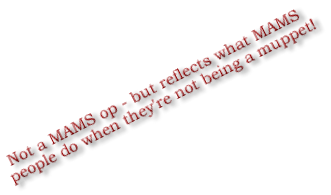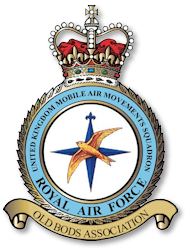

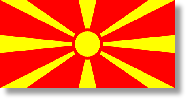

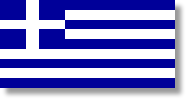
There was a 50/50 chance of me not getting caught for a deployment to Macedonia with JHSU as the Operations Officer. That was until the young pongo Captain broke his ankle...
From June 2nd 1999 we were warned that we would be on 5 days notice to move and preparations continued, but at Army speed - not RAF Movements!
On Thursday 3rd June my wife travelled down from Swindon to Odiham for the night as we had been invited to a BBQ at the Station Commander's house. There was obviously something going on as he was receiving lots of visitors. The deployment of the first two Chinooks had been brought forward to that Saturday - so much for the 5 days notice. Anyway, a good night was had by all.
At 0830 the next morning my OC asked me if there was any reason why I couldn’t fly out to Macedonia on the Chinook the next morning!
On Thursday 3rd June my wife travelled down from Swindon to Odiham for the night as we had been invited to a BBQ at the Station Commander's house. There was obviously something going on as he was receiving lots of visitors. The deployment of the first two Chinooks had been brought forward to that Saturday - so much for the 5 days notice. Anyway, a good night was had by all.
At 0830 the next morning my OC asked me if there was any reason why I couldn’t fly out to Macedonia on the Chinook the next morning!
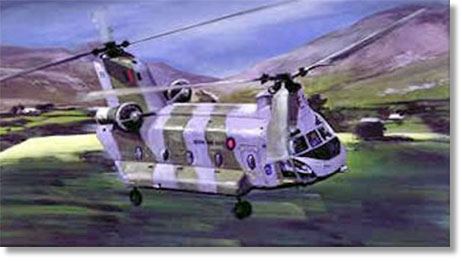
Everything then became a blur - deployment meetings with 27 Sqn Detachment Commander and planners as well as trying to organise my own guys. By midday I had exchanged my bergan in for a bigger one to accommodate the mass of extra kit I was issued, it certainly wasn’t like this on MAMS! I was then able to make it home for the night, planning to return to Odiham (60 miles away) at 0600 the next morning.
Whilst at home, there was good news and bad news - I didn’t have to return to Odiham to fly on the Chinook as there was a Hercules leaving Lyneham (closer), however, I had to be processed through the Air Mounting Centre (AMC) at South Cerney. To cut a long story short we arrived at our final destination, Prilep in Southern Macedonia at 0330 Sunday morning after a 20-hour journey. Although pretty dehydrated, the accommodation was reasonable being 16-man rooms (bare stone floored) in a Macedonian Army Barracks. Sleep was difficult however due to the constant jet roar way overhead as this was the rendezvous point for all tankers and bombers before they flew on to Kosovo and Yugoslavia, yes, the NATO bombing was still going on.
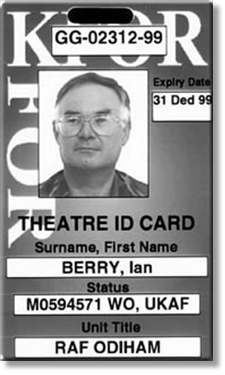
Unlike the rest of the troops, I only had one night in this location before leaving them to fly forward on a Puma to Petrovec Training Area. This was close to Skopje where I met my BBQ host from the previous Thursday - now the SH (Support Helicopter) Force Commander. This was when I learned how to travel light as a SA80 (rifle), 120 rounds in 4 magazines, morphine syrette, CBA (Combat Body Armour - flak jackets), webbing, 48 hours rations, bayonet, sleeping bag and bergan is just about enough for someone then aged 50!
Here the work and planning began in earnest, being initially co-located with HQ 4 Armoured Brigade where I met Sqn Ldr Dave Lester-Powell (OC UKMAMS designate with effect from Aug 02) who was involved in the planning of the armoured invasion of Kosovo, work that one out... I did the rounds of the campsites meeting the Irish Guards, Household Cavalry and the like and seeing what we could do for them with Chinooks. In quick time I undertook a task for the Armoured Engineers who wanted to know if we could fly their No 12 Tank Bridges, which weighed 6 tons each. If you don’t know, under slinging from Chinooks is a science and we use cranes and the like to ascertain C of G’s and to devise the best rigging schemes. The next day I had some of my men flown forward from Prilep and we trialled the bridge and that same afternoon flew it for real with a Chinook which proved successful. I also carried out recce’s at the Stenkevec Refugee Camp which is quite an emotional place and a wheat filed near Brazda on the Macedonian/Kosovan border which would become the focal point of the media in just under three days time.
By Wednesday 9th June 6 Pumas and 4 Chinooks were ‘in-theatre’ as well as 22 personnel of JHSU. Tasking began to pick up and that afternoon we arranged a flying display for the press, which included ‘Oh my God’ Kate Adie. (Nb: It was known throughout the force that if BBC Reporter Kate Adie appeared then there was going to be shooting!). The temperature was now in the mid 30s and the local area was extremely dusty. Swirling clouds of dust appealed to the press but not to us, however, they got their own way. That afternoon the balance of JHSU arrived bringing the strength up to 32. That same day the peace agreement was signed but the remnants of Para’s and Ghurka's from 5 Airborne Brigade were still flying into Skopje.
I nearly got to sleep that night but was rudely awoken from my bed under the stars to be summoned to the Ops Tent where I spent most of the early hours planning a deployment of troops and equipment of 5 Brigade into Kosovo. The 2i/c, a man who will remain nameless (RAF Officer) was also summoned to assist but instead handed over his mobile phone and went back to sleep! The pace continued to increase and most of the unit was ‘warned off’ to deploy to the border area near Brazda departing at 0930. The plan was to fly forward to that location 1500 troops in readiness for a deployment into Kosovo. At that time none of the teams had got their act together (all army) and as I knew the first helicopter was due to arrive at 1130 I disgustedly handed over my maps to the remaining man in charge and departed with my own vehicle and radio operator.
This proved to be a good call as the MAOT (Mobile Air Operations Team) who were coming from elsewhere also got stuck and I ended up receiving waves of troop laden Chinooks and Pumas for two hours until my teams finally arrived. During this phase I met the BAMO (ex-UKMAMS) Flt Lt Paul ‘Combat’ Connor stepping off the back of a Chinook to join the rest of the Brigade, his deployment task having ended. At the end of the move from Petrovec, over 1500 soldiers had been flown into an area that became known as ‘Piper HLS’. This was to be my home for the next few days and with 800 Ghurkas camped around me I couldn’t have asked for better neighbours. Their morning and evening stand-to’s being announced with the playing of bagpipes!
Although the peace deal had already been signed D-Day (the entry into Kosovo) was planned for Friday 11th June. Once across the border the first 15kms of road into Kosovo is through the Kecanik Defile, a very steep valley with the road half way up the side and passing through two road tunnels and over two bridges spanning deep gorges.
The plan was that a 127km long convoy of armoured vehicles of 4 Brigade led by Challenger tanks would cross the Kosovo border whilst elements of 5 Brigade would be flown in by helicopter into the defile landing on the road throughout the defile to ensure there were no mines or booby traps. That was the plan but no sooner had the helicopters landed in the wheat fields and the troops were in their chalks ready to embark when the situation changed.
The plan was that a 127km long convoy of armoured vehicles of 4 Brigade led by Challenger tanks would cross the Kosovo border whilst elements of 5 Brigade would be flown in by helicopter into the defile landing on the road throughout the defile to ensure there were no mines or booby traps. That was the plan but no sooner had the helicopters landed in the wheat fields and the troops were in their chalks ready to embark when the situation changed.
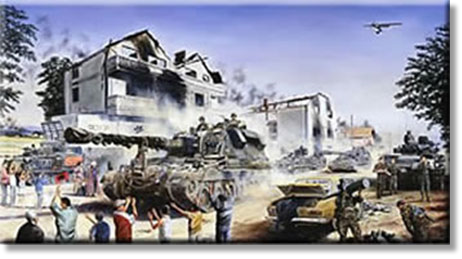
It transpired that the Russians had ‘stolen a march’ on NATO and elements from IFOR in Bosnia were on their way to Pristina Airport. For the next hour it was ‘on the bus, off the bus’ as we waited for our political mentors to make a decision. In the end it became a ‘no-go’. It was only months later we discovered this was the consequence of an argument between Lt Gen Michael Jackson and Gen Clark (SACEUR) who wanted 5 Brigade to capture the airfield. D-Day was delayed until 0530 on Saturday 12th June but this meant another straight 24 hours work for JHSU to rig all the loads now to be underslung and flown into the defile.
After a further night of planning and briefings and preparation we were all in our positions ready for the big outload beginning at 0530. My task was to be the ‘Beachmaster’, otherwise known as the ‘MC’ who controlled the landing zone and allocated aircraft to loads and lanes. For the planned six hours outload we would be using 8 Chinooks and 5 Pumas, the plan was for 99 lifts including 38 underslung and 1260 troops internal. We planned and used three load lanes, forward, left and centre for Chinooks with troops and underslung loads, aft left and centre for troops only and the right hand lane for Pumas who carried troops only.
At 0530 just after dawn all aircraft were sat in the wheat field, their rotors turning. Nothing was lifting and I began to wonder what the problem was when with total surprise six Apache helicopters appeared and acted as escorts for the Chinooks and Pumas. For everyone who witnessed this it was indeed breathtaking and history in the making. The lifts continued without a break for the next two and a half hours until we had cleared the fields and holding areas, mission accomplished in less than half the time planned. The operation was justified as well as one of the tunnels was mined and it took four hours to clear. One mine was detonated by the downwash of a helicopter’s rotors but we had no casualties. 4 Brigade were through the defile within six hours and heading for Pristina.
That first evening one of my teams was tasked to fly into the defile and re-rig the engineer’s landrovers and tractors for onmove further into the country. Most of the verges of the riads in the defile had been mined but unless it prevented further military movement the mined areas were taped off and left uncleared. At this time the towns and villages were also still deserted and the area was still somewhat ‘hostile’. Amongst the 6 man team who landed by Puma was SAC ‘Scoggy’ Scoggins, one of the RAF movers on this joint unit. No sooner had the helicopter departed than a couple of mortar rounds exploded somewhere in the distance accompanied by a burst of tracer. The army members of the team ‘cocked’ their weapons whilst Scoggy turned pale! Sometime later a patrol of 1 Para led him to a field where the tractor he was to rig was located. On the way there he amused them all by declaring that if they did not desist from using hand signals, which he didn’t understand and speak to him, he would go no further! On arriving at the field and ascertaining it had not been swept for mines he displayed forceful autocratic skills no one though he was capable of! Humour aside though, he proved that RAF Movers can ‘cut it’ when required...
Whilst this was happening the other two teams were also hard at work. One team was still at Petrovec outloading rations, ammo and equipment from the 5 Brigade logistics area forward into Kosovo. I mentioned the hot conditions that continued to get worse. Each soldier was required to drink 6 litres of water per day. On D-Day plus one we flew over 43 tons of bottled water alone. The third team found themselves alongside Stenkovec Refugee Camp where they had to rig and fly two sets of pipe fascines (used by Armoured Engineers to cross tank ditches) and six of the newly cleared No 12 tank bridges. The latter task was quite intensive with obstacles all around the items to be lifted, the Royal Engineers were able to remove a lamp post for me in short order but the broken down M1 Abrams tank 20mtrs to the rear was staying where it was! We had insufficient rigging equipment for everything but two men would fly forward and recover the slings ready for use again. Throughout the morning we were surrounded by at least 200 Kosovan children from the camp who were now ecstatic knowing their country had been liberated and being inquisitive were into everything.
We returned to the same location the next day to move a Field Hospital north to Pristina. At this stage 12 men from JHSU deployed ‘up-country’ into Kosovo to a site known as Pegasus 04, just outside of Lipljan and 15kms South West of Pristina. We were to keep a presence here for the next 5 week, rotating the teams every 5 days. I personally remained at Piper Camp with the RE’s for 10 days before returning to several locations within the confines of Skopje Airfield. I also spent several days within Kosovo and the changes from D-Day became more and more noticeable as time progressed. For the first couple of days the border crossing was mayhem with literally thousands of refugees pouring back into Kosovo. The devastation was selective and vindictive with just odd houses destroyed in some locations and whole villages in others. As time progressed the retaliation against the remaining Serbs began and house burning became the norm again. The NATO bomb damage was, dare I say, impressive and clinical with normally pinpoint accuracy.
Although we travelled within the country armed and wearing CBA the fact was that we ran greater risks on the journey through the outskirts of Skopje on the way to the border. This was due to the indiscriminate stoning of military vehicles by the local children. We alone had to replace two windscreens after receiving several direct hits. The worst incident though was when one vehicle stopped and was rammed by a Landover from behind; the driver subsequently had his legs amputated.
As the weeks progressed the workload eased and we began to return personnel home. However, we did have some work once Pristina Airport re-opened. A HeavyLift Antonov 124 (with Gerry Moffett ex-MAMS amongst the crew) delivered two pairs of aircraft steps for handling VC10’s. The steps however were too high once on a low-loader to pass through the Kosovan road tunnels. In response to a request from Sqn Ldr Geoff Green, OC MAMF at Skopje, that could we undersling them? I accepted the challenge. After some trials that’s what we did. To the uninitiated on the ground several people thought they were looking at a new type of missile launcher. I’m still waiting incidentally for the outstanding balance of a slab of beer though!
By late July my unit had only 5 personnel left in Macedonia including myself as we withdrew from theatre along with the Chinooks. By the end of August 1999 we had all returned home and some time later were all rewarded with a NATO Kosovo medal. It was an interesting experience enabling me to see sights and endure situations I never imagined, especially as an Airman. I’ve now probably had my last Ghurka curry and am now serving out my time at good old Lyneham.
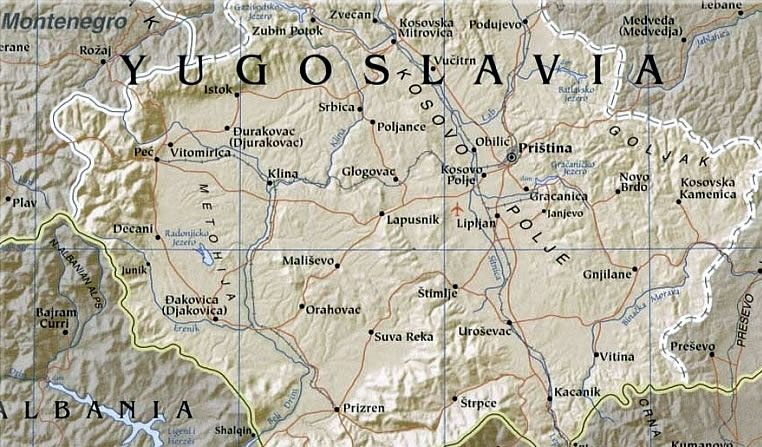
In between lifts they all wanted to wear our helmets and goggles and once an aircraft returned with recovered rigging equipment even the crews were bemused to see a ‘snake’ of children carrying the slings for us. For the uninitiated a Chinook creates a very strong downdraught of wind when it lifts off. In one instance I noticed out of the corner of my eye two blue and white coloured objects shooting along the ground like bullets. They were in fact portaloos, and just as I said “wouldn’t it be funny if...” two rather wet, aptly named brown jobs climbed out!
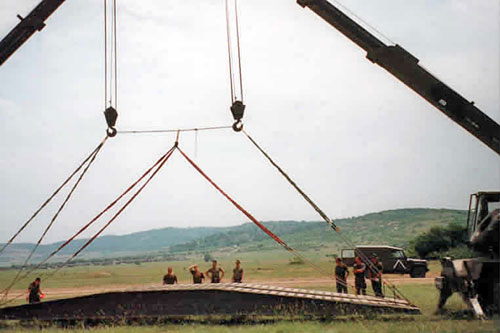
This is a No12 Tank Bridge which is laid by an AVRE (Armoured Vehicle Royal Engineers) - a Chieftain tank chassis in other words. It can span a tank ditch or river 30 feet wide.
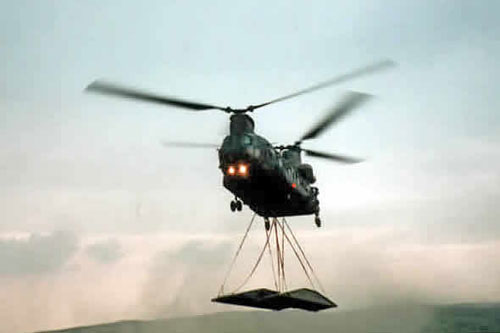
Once we'd worked out the angles and dangles using 2 cranes, we 'whistled up' a Chinook for the real thing. We need to trial-fly items so as to work out safe maximum angles of bank, speed and the maximum rate of decent. We used 2 cranes only because we were going to use 2 hooks ie: Tandem Hook
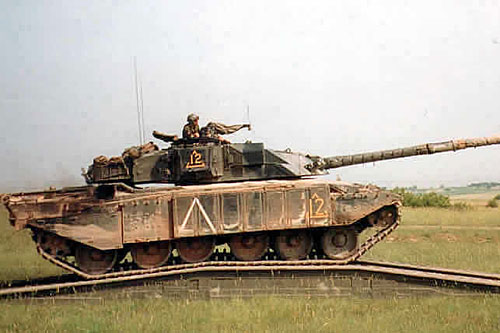
Whilst waiting for the Chinook to appear this tank crew thought it a great laugh to cross the bridge. The end result was that we had to dig out the ends to attach the rigging again as a Challenger Tank weighs 66 tons!
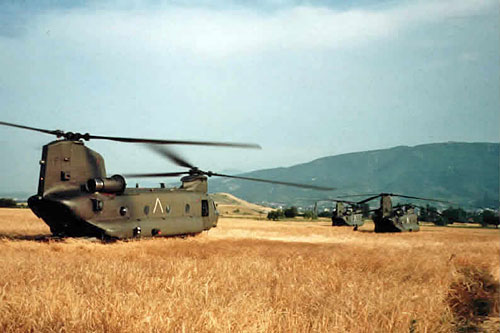
D-Day - The lift from Piper Hills. This was the start of the big lift. The picture shows Chinooks loaded with rotors turning, waiting for the off
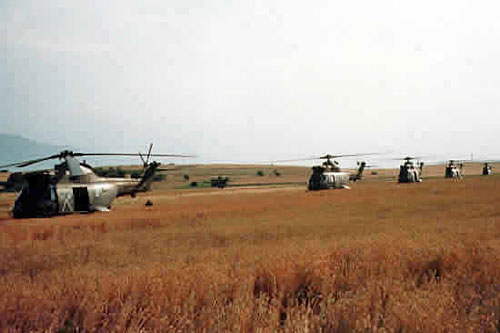
Lane 3 - The Pumas wait for their turn
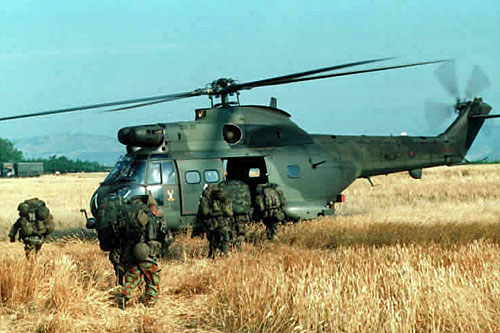
Although the Puma can carry 16 troops, because of the heat and individual weight the troops were carrying, we restricted the loads to either 10 Paras or 12 Gurkhas.
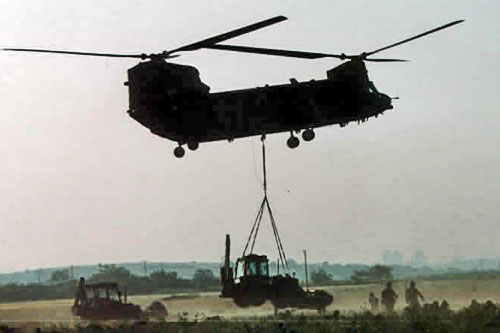
32 troops have already climbed into the Chinook and now he's moving off with the digger. They use them to dig trenches and assist in mine clearance etc.
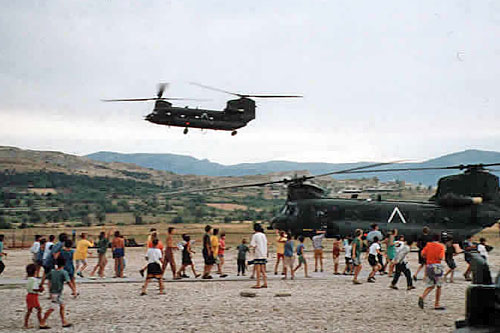
Outload from Stenkovec Refugee Camp. There were a lot of kids hanging around, however they didn't get as close to the Chinooks as it may seem.
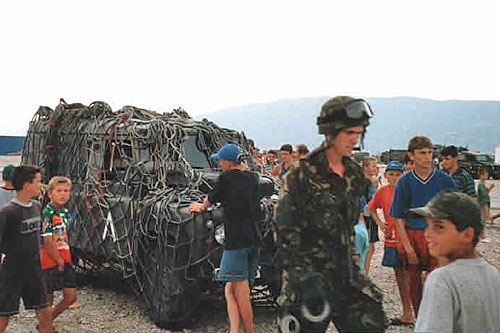
Rent-A-Crowd! There were excitable kids everywhere, still, you couldn't blame them.
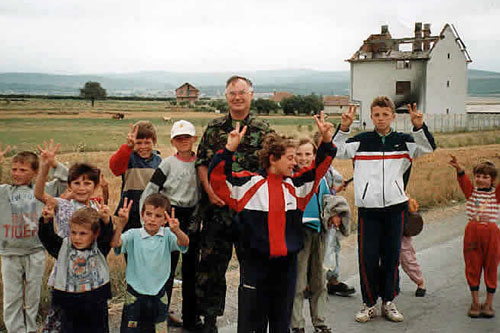
Ambushed by Kids in Kosovo! We stopped for a call of nature in the middle of nowhere and out came all these kids!
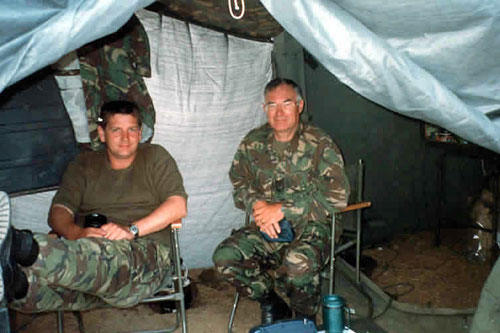
Inside my Little TAC Headquarters. The guy on the left is 'Johnno' Johnson who was my Signals Sergeant - and very professional. Note the sun tan as I was fortunate to have acclimatised with a fortnight in Corfu just before we went on standby.
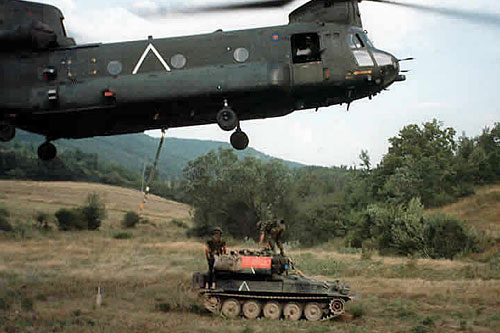
Move of CVRT up-country. This is one of our 'bread and butter' lifts a CVRT (Combat Vehicle Recce Tracked). This one was from the 'Swimming Pool' LS North East of Pristina and the vehicle belongs to the Household Cavalry. It's also 3 tons heavier than worked out by JATE as when they do trials they forget that in reality it also carries 120 rounds of 30mm ammunition, 2,000 rounds of 7.62mm ammunition, 5 days rations, water for 3 men and their sleeping and washing kits.
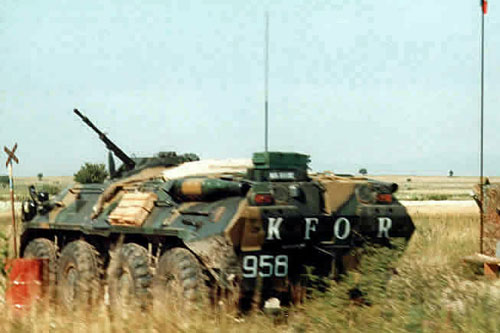
Russian checkpoint on western edge of Pristina airport. We met the Russians several times - to give them water and the like.
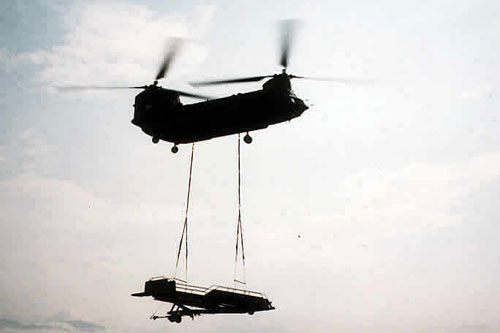
Move of Hi-Rise Aircraft Steps to Pristina. After rigging trials this is the second of two live lifts to Pristina, I flew up on the first.
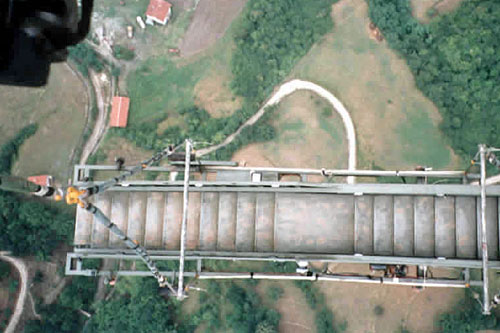
Looking down at the steps. This is what it looked like from the trapdoor in the Chinook. It's okay as long as you're not too scared of heights!
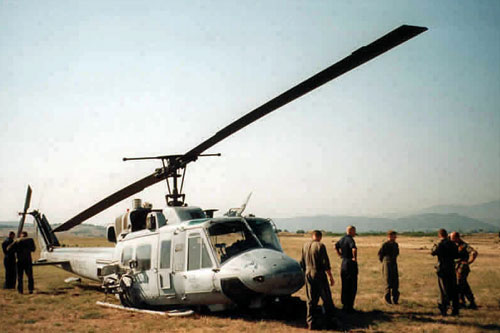
US Marine Corps Broken Huey. This USMC Huey had a hard landing on our tactical refuelling site and broke his skids. We offerred to recover them but they declined. The aircraft eventually went Stateside in the back of a C17.
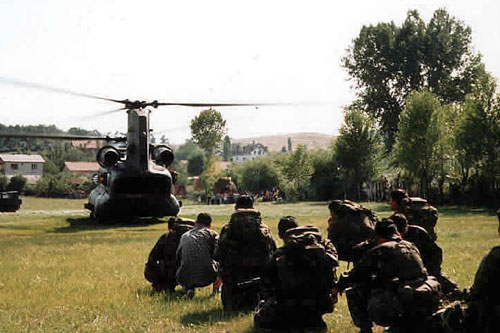
Gurkha Quick Reaction Force - Mageera, Kosovo. This was a practice move of the QRF who were from the 1/7 Ghurka Rifles at the time.
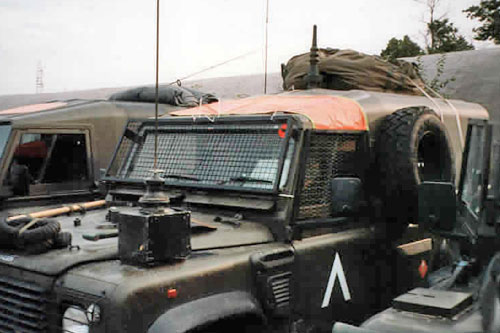
The remedy to counteract the stone throwers, fitting IS (Internal Security) grills to the Wolf Landrovers.
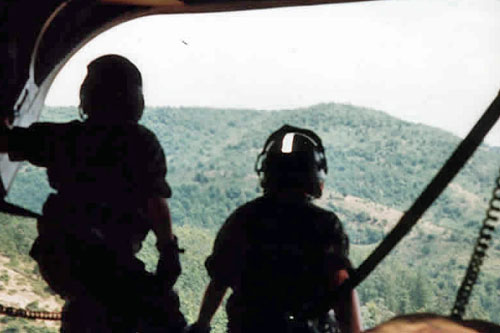
Flying through the Kecanik Defile - the only southern way into Kosovo from Macedonia. The only way to travel, noisy but fast. The guy on the right is 'ramp riding' which is very exhilarating. The crewman's trick was to tap you on the shoulder and wave the loose hook end of a spare harness - it normally worked!
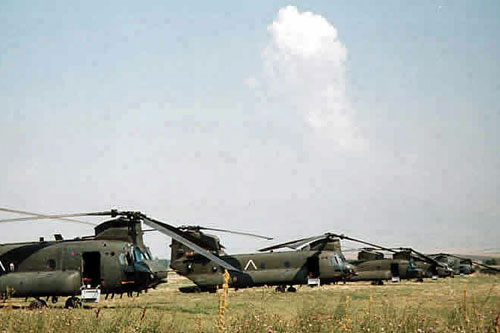
Chinooks at the APOD Skopje Airport. This is Skopje Airport from where the Chinooks and Pumas operated from June
to August. APOD is the latest military yuckspeak meaning Airport of Disembarkation!
to August. APOD is the latest military yuckspeak meaning Airport of Disembarkation!
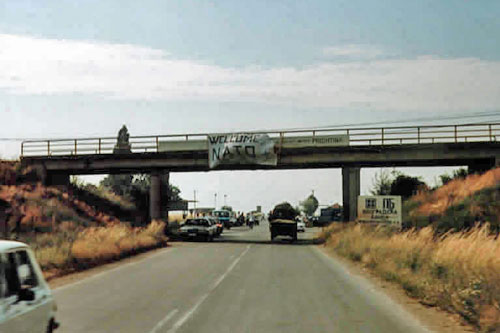
Welcome NATO!
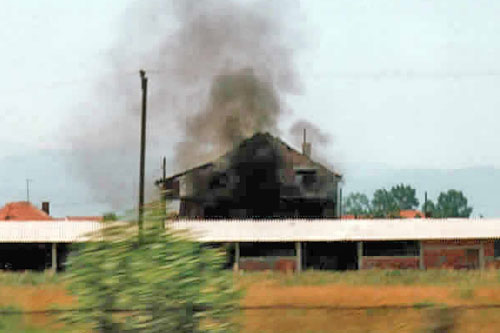
The burning continued when I left, only this time it's the Kosovans burning out the remaining Serb families - what a mess! The Serbian Army's method of torching a house was to leave a lighted candle in the attic and turn on all the gas taps!
